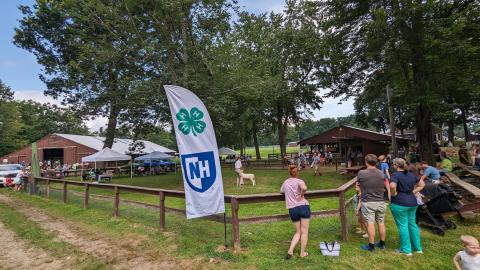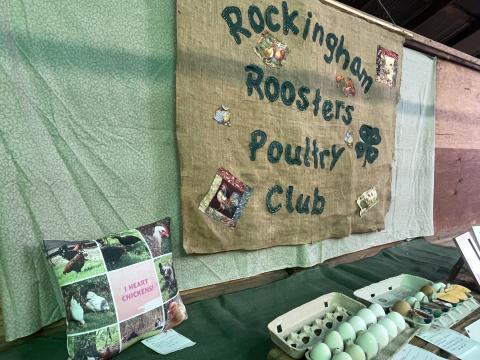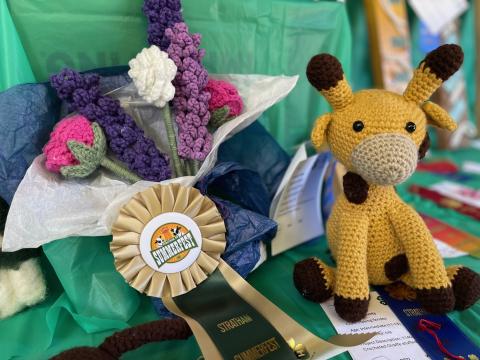For the Love of the 4-H Exhibit Hall
Fair Season is upon us. Visiting county fairs is a favorite summer pastime and tradition for many families. Each of these events has their own, unique flair, but all fairs share the same elements of excitement and good energy.
Public announcements travel through the warm summery air, and the smell of fried dough carries a hint of barn. Farm sounds are surrounding us, dogs are barking, and kids are running past you, giggling with excitement.

You will see 4-H youth tending to their animals, feeding them, washing, and trimming their fur to get them ready for the show ring.
There are local organizations such as boy scout troops selling good old-fashioned lemonade, and fair goers who are enjoying a much-needed ice cream in the summer heat.
The 4-H symbol of the four-leaf clover, representing the 4hes for Hearts, Hands, Head and Health, can be spotted around the animal show rings and the 4-H exhibit hall.
While 4-H and animals are associated with county fairs, a lesser-known gem is hidden in plain sight: The 4-H Exhibit Hall.
Most visitors will hit the more obvious fair highlights like animal shows and sheep dog demos, toddlers will sit with beaming smiles in various first responder trucks, and then there are the long lines in front of our favorite fair food trucks and booths.
After all these first stops, most folks will meander a bit aimlessly through the 4-H Exhibit Hall, taking a few quick looks at crafts and projects, just to exit the barn building at the opposite end, heading for their cars. But they are missing out...

There are handsewn garments on display, made from wool, with factsheets about the advantages of wool garments, and how wool can keep you warm in the winter and cool in the summer. Further down the aisle, you can find collections in the showcases that will show a budding scientist’s approach to researching and displaying New England’s seashells.
The more time I get to spend in the 4-H barns, the more smitten I become with the artifacts I am looking at, and the enthusiasm and curiosity that sparked these club and individual entries.
The items on display are the result of an extended project planning period: The 4-H year starts on October 1st. Over the course of fall, winter & spring, youth, with guidance of their guardians and/ or a club leader, will create a plan on how to achieve their goal: A topic they’d like to explore, a skill they’d like to learn or a craft they would like to complete and master. They will ask themselves: What is a topic/ skill/ craft that I want to learn more about? How can I best achieve that? What is my timeline?
The finish line for their projects will be the fair season, which is like the championship game of 4-H. Youth are constantly honing their skills on “Making the Best Better “(4-H’s Motto), may it be for animal showings or entries for the 4-H Exhibit Hall. They are proud to show their animals in the showring, and they are proud of the more “still” displays in the Exhibit Halls.
Next time you are visiting a fair and find yourself meandering through the 4-H Exhibit Hall, do yourself a favor and take a closer look at the posters, crafts, garments, and canned goods. These items tell the story of curiosity, grit, determination, and tireless efforts to get better at a skill.

Read the small cards next to the items, and you may be surprised by the age of the 4-Her that took a brilliant photograph, incorporating all rules of composition, focus and lighting. To you it may be just a good picture, but the story behind this image is that the young photographer might have enjoyed lessons with a project leader and numerous attempts to get better at their skills and to get this good.
If you see young 4-Hers manning their exhibits, ask them why they chose that topic to explore, what they learned by doing so and what their favorite part of the project was.
Volunteer as a judge to take a deeper look at exhibit hall projects and to provide meaningful and encouraging feedback to the budding bakers, the inquisitive engineers and skilled craftsmen and craftswomen of tomorrow. You will learn a lot, and their curiosity and skills won’t fail to impress you.
The 4-H Exhibit Hall is an excellent example of “Learning by Doing”, and next time you are at a county fair, we would like to invite you to take some time to visit and to be fascinated by the youth's various skill sets and interests.



